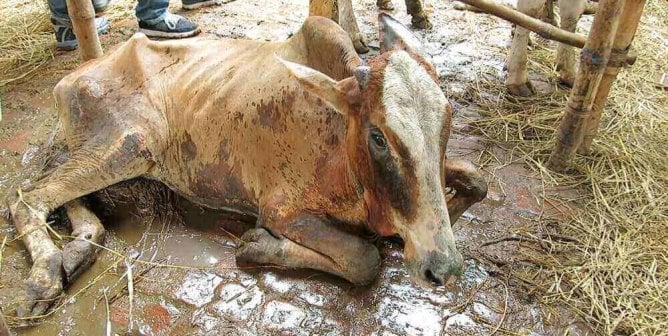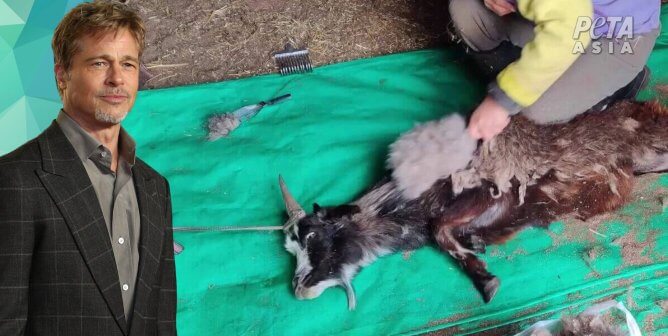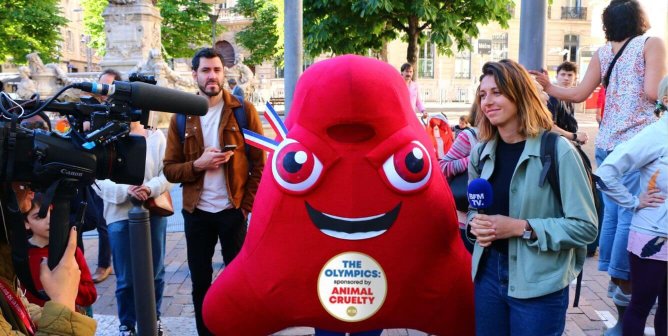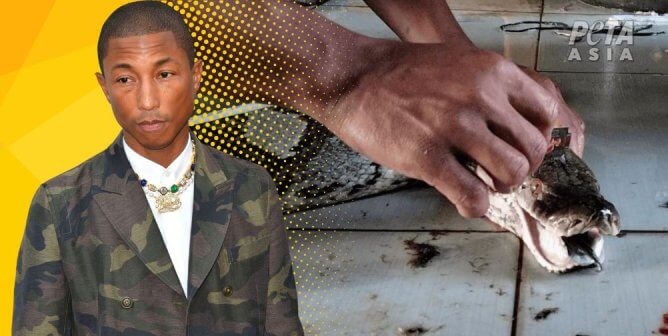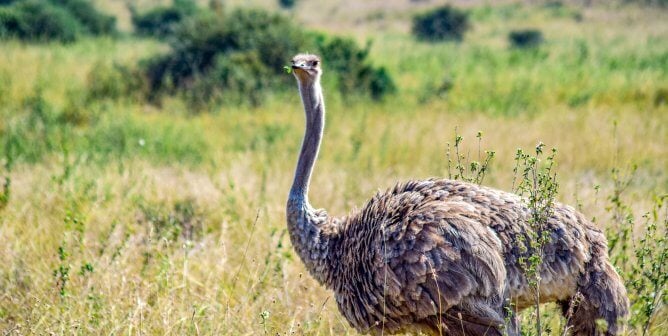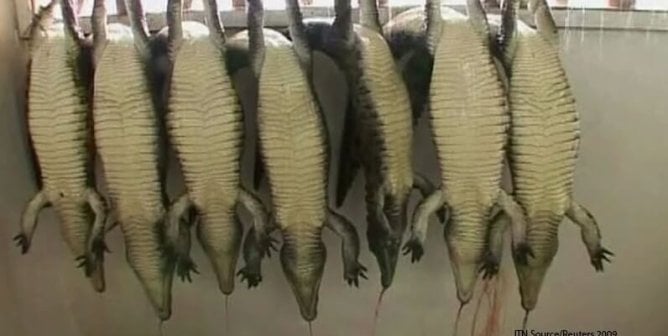Leather: Animals Abused And Killed for Their Skins
Every year, the global leather industry slaughters more than a billion animals and tans their skins and hides.1 Many of these animals endure all the horrors of factory farming—including extreme crowding and confinement, deprivation, and unanesthetized castration, branding, and tail-docking—as well as cruel treatment during transport and slaughter.
Everything but the Moo
The multibillion-dollar meat industry profits from more than just animals’ flesh. The coproducts of meat consumption include fat and blood that are used in livestock feed, tires, explosives, paints, and cosmetics; organs that are used in pet food; and heart valves that are used in medicine.2,3 The skin of the animal is often considered to be a significant economic co-product of the meatpacking industry.4
When the milk production of cows in the dairy industry declines, their skin is made into leather. The hides of their calves, who are frequently raised for veal, are made into high-priced calfskin. The economic success of slaughterhouses and dairy farms is directly linked to the sale of leather goods.
The Whole Ark
Most leather produced and sold in the U.S. is made from the skins of cattle and calves, but leather is also made from sheep, lambs, goats, and pigs. Other species are hunted and killed specifically for their skins, including zebras, bison, kangaroos, elephants, crocodiles, alligators, ostriches, lizards, and snakes.
Other “exotic” animals, such as alligators and crocodiles, are factory-farmed for their skins and meat. The young reptiles are often kept in tanks above ground, while bigger animals live in pools half-sunken into concrete slabs.5 According to Florida’s regulations, it is legal to put as many as 350 6-foot alligators into a space the size of a typical family home.6 The industry is so large and unregulated in that state that alligators and eggs are often poached for high prices.7 One Georgia farmer had 10,000 alligators living in four buildings, where, according to the Los Angeles Times, “[h]undreds and hundreds of alligators fill every inch of [each] room.”8
Dr. Clifford Warwick, a reptile biologist, says that such confinement can cause injuries and stress. “[Alligators’ and crocodiles’] biology and behaviour do not lend themselves to a captive life,” he says. “To a casual observer—and that often includes the people who run crocodile farms who are not usually scientifically qualified—the animals may seem peaceful and relaxed. But an animal behaviourist can see that they are stressed.”9
Although alligators can live up to 60 years, farmed alligators are usually butchered before the age of 2, as soon as they reach 4 to 6 feet in length.10,11 Alligators on farms may be beaten to death with mallets and axes, sometimes remaining conscious and in agony for hours after they’re skinned.12 On alligator and crocodile farms in Texas and Africa, PETA eyewitnesses saw alligators packed in dank pools and crocodiles crowded in barren concrete pits for months or even years before finally being slaughtered for their skins. An investigation into crocodile farms in Vietnam revealed that animals were skinned alive, and a biologist who viewed video footage of the slaughter concluded that “there was no probability the animals died instantly, and that they likely remained conscious and sensitive to stress and pain for up to two hours after the process.”13 For more on the appalling conditions in which these animals are raised and/or killed for “luxury” bags, belts, and watchbands, visit PETA.org.
Kangaroos are slaughtered by the millions every year, and their skins are often used for soccer shoes.14 Although the Australian government requires that hunters shoot the animals, orphaned joeys and wounded adults are, according to the government, to be decapitated or hit sharply on the head “to destroy the brain.”15 After learning about these cruel killing methods, soccer star David Beckham switched to shoes made from synthetic materials in 2006, and Adidas stopped using kangaroo skin for most of its shoes in 2012.16 In 2023, both Nike and Puma announced they would stop using kangaroo skins in their products, including soccer shoes.17
Snakes may be nailed to trees and skinned from one end to the other. In many cases, they’re still alive as they’re skinned.18 A PETA Asia investigation into a farm in Vietnam that supplies snakeskin for use in the global leather industry revealed horrific cruelty to snakes, including sealing their mouths and anuses with rubber bands and then inflating them to death with an air compressor, crushing their heart and causing severe pain. PETA Asia’s footage shows a snake’s tail moving during the lethal inflation, indicating that the pythons may still be alive as workers tear their skin off and disembowel them. The investigator did not see anyone checking vital signs before beginning the butchery. The snakes were held in cramped, dirty wire cages without water, food, or any enrichment. After learning that many of them had mites, a PETA Asia investigator asked about veterinary care, and a worker replied, “What’s the point [of treating the snakes]? We skin them anyway.” For more on this investigation, please visit PETA.org.
The skins of unborn calves and lambs—some purposely aborted, others from slaughtered pregnant cows and ewes—are considered a “luxury.”19
The Western Cape of South Africa is home to the largest ostrich slaughter companies in the world, which supply “luxury” ostrich skins to Hermès, Prada, and other major fashion houses. PETA eyewitnesses saw young birds tightly packed into open-topped vehicles for the terrifying journey to slaughterhouses, where workers forcibly restrained each bird, electrically stunned them, and then cut their throats. Moments later, the feathers were torn off the birds’ bodies, and they were skinned and dismembered. For more about this investigation, please visit PETA.org.
Shearling, contrary to many consumers’ misconceptions, is not sheared wool—the term refers to a yearling sheep who has been shorn just once. A shearling garment is made from the skin of a sheep or lamb who is shorn shortly before slaughter. The skin is tanned with the wool still on it.
Tannery Toxins
Although leather makers like to tout their products as “biodegradable” and “eco-friendly,” the process of tanning actually stops the leather from biodegrading by stabilizing the collagen or protein fibers.
Until the late 1800s, animal skin was air- or salt-dried and tanned with vegetable tannins or oil, but today, animal skin is turned into finished leather with a variety of much more dangerous substances, including formaldehyde, coal-tar derivatives, mineral salts, and various oils, dyes, and finishes, some of which are cyanide-based.
Most leather produced in the U.S. and around the world is chrome-tanned. The Environmental Protection Agency considers all wastes containing chromium to be hazardous. In addition to the toxic substances mentioned above, tannery effluent also contains large amounts of other pollutants, such as protein, hair, salt, lime sludge, sulfides, and acids. A chrome-tanning facility wastes nearly 15,000 gallons of water and produces up to 2,200 pounds of “solid waste” (e.g., hair, flesh, and trimmings) for every ton of hides that it processes.20
Among the disastrous consequences of this noxious waste is the threat to human health from the highly elevated levels of lead, cyanide, and formaldehyde in the groundwater near tanneries. In Bangladesh, which exports leather goods to the United States, chemical exposure and equipment accidents pose such a great hazard that workers (many of them children) aren’t expected to live beyond age 50.21 The Centers for Disease Control and Prevention found that the incidence of leukemia among residents in an area surrounding a tannery in Kentucky was five times the national average.22 Arsenic, a common tannery chemical, has long been associated with lung cancer in workers who are exposed to it on a regular basis. Several studies have established links between sinus and lung cancers and the chromium used in tanning.23Studies of leather-tannery workers in Italy and Sweden found cancer risks “between 20% and 50% above [those] expected.”24
Raising animals for food and leather creates waste and pollution. Huge amounts of fossil fuels are consumed in livestock production: It takes about 35 calories of fossil fuel to make one calorie of beef and 68 calories of fossil fuel to make one calorie of pork.25 Researchers at the University of Chicago found that the typical American diet (nearly 30 percent of which comes from animal sources) generates the equivalent of nearly 3,300 pounds more carbon dioxide per person per year than a vegan diet with the same number of calories.26
Trees are cut down to create pastureland, vast quantities of water are used, and run-off from feedlots and dairy farms is a major source of water pollution. A California study found that a single cow on a dairy farm “emits 19.3 pounds of volatile organic compounds per year, making dairies the largest source of the smog-making gas, surpassing trucks and passenger cars.”27
According to the United Nations’ Food and Agriculture Organization, tanneries have largely shifted operations worldwide from developed to undeveloped nations, where labor is cheap and environmental regulations are lax.28
What You Can Do
Try vegan leather! It can be made from polyurethane, a resilient, flexible, and durable material that can be molded into a variety of goods, or from materials such as pineapple leaves, cork, apple peels, other fruit waste, or recycled plastic. Chlorenol (called “Hydrolite” by Avia and “Durabuck” by Nike) is a material that is perforated for breathability and is used in athletic and hiking shoes. It stretches around the foot with the same “give” as leather, provides good support, and is machine-washable. As a coproduct of the meat industry, cow leather is worse for the environment than any vegan leather.
Leather alternatives can be found just about anywhere you might shop. But some places, such as discount shoe and variety stores, offer larger selections. Designers such as Liz Claiborne, Capezio, Sam & Libby, Steve Madden, and Nike offer an array of nonleather handbags, wallets, and shoes. For a longer list of merchants that offer nonleather products, visit PETA.org.
References
1Food and Agriculture Organization of the United Nations, Producing Animals/Slaughtered 2020, FAOSTAT Database, accessed 7 July 2022.
2DAR PRO Solutions, “Meat By-Product FAQs,” DAR PRO Solutions, 2022.
3A. Severin Johnson, “Packing House Byproducts,” Agricultural Marketing Resource Center, Iowa State University, Feb. 2003.
4Bloomberg, “America’s Obsession With Beef Is Killing the Leather Industry,” 14 Aug. 2019.
5Michael P. Masser, “Alligator Production,” Southern Regional Aquaculture Center, May 1993.
6Masser.
7Jennifer Lipscomb,”An Undercover Sting Illuminates the Dark Side of Florida’s Booming Alligator Industry,” Miami New Times 18 July 2017.
8Edith Stanley, “Chicken Again? These Gators Get a Steady Diet of Dead Fowl,” Los Angeles Times, 10 June 2001.
9Sanjida O’Connell, “Crocodile Farms: Is It Cruel to Keep These Wild Creatures Captive?,” The Independent, 5 Oct. 2006.
10Zoological Society of San Diego, “Crocodilian,” Animals and Plants, 2019.
11Masser.
12O’Connell.
13Brett Davis, “Crocodiles In Vietnam Skinned Alive In Service Of Fashion,” Forbes, 22 Dec. 2016.
14Australian Government Department of the Environment, “Commercial Kangaroo Harvest Quotas in 2012,” accessed 18 Aug. 2019.
15The Natural Resource Management Ministerial Council, National Code of Practice for the Humane Shooting of Kangaroos and Wallabies for Commercial Purposes, Department of the Environment, Water, Heritage and the Arts, 2008.
16Sean Poulter, “Kangaroo Leather Gets the Boot From Adidas,” Daily Mail, 3 Sept. 2012.
17Dan Hajducky,”Nike, Puma To Stop Using Kangaroo Leather in Soccer Boots, All Products,” ESPN, 13 March, 2023.
18Tom Rawstorne, “Snakes Skinned Alive to Create Beyonce’s Boots of Blood: True Price of the Trainers Made From FOUR Exotic Creatures,” Daily Mail, 1 Mar. 2013.
19Eric Wilson, “The Lamb on the Runway,” The New York Times, 11 Aug. 2005.
20Doris Schubert, “Assessment of the Environmental Release of Chemicals From the Leather Processing Industry,” IC-07 Leather Processing Industry, 28 July 1998.
21Jason Motlagh, “Hell for Leather: Bangladesh’s Toxic Tanneries Ravage Lives and Environment,” Time 13 Nov. 2013.
22Richard E. Sclove et al., Community-Based Research in the United States (Amherst: The Loka Institute, 1998) 52.
23Richard B. Hayes, “The Carcinogenicity of Metals in Humans,” Cancer Causes and Control, 8 (1997), 371–85.
24France Labrèche, Ph.D., Occupations and Breast Cancer: Evaluation of Associations Between Breast Cancer and Workplace Exposures (Montréal: McGill University, 23 Dec. 1997).
25Richard Manning, “The Oil We Eat,” Harper’s Magazine, Feb. 2004.
26 New Scientist, “It’s Better to Green Your Diet Than Your Car,” 17 Dec. 2005.
27Jennifer M. Fitzenberger, “Dairies Gear Up for Fight Over Air,” Fresno Bee, 2 Aug. 2005.
28Intergovernmental Group on Meat, Sub-Group on Hides and Skins, Food and Agriculture Organization of the United Nations, “Hides and Skins and Skins and Leather Commodity Profile and Strategy for Development,” Committee on Commodity Problems, Seventh Session, 4–6 June 2001.

